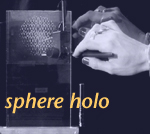
|
wendy
plesniak
|
||||||||||
|
&
michael klug
|
||||||||||
 |
 |
|||||||||
| These early experiments combined static, optically | ||||||||||
| printed holographic stereograms of simple scenes | ||||||||||
| with force models of the same geometry and texture. | ||||||||||
| The holograms are monochromatic, have full parallax, | ||||||||||
| and reconstruct entirely in front of their image plane | ||||||||||
| (in the viewer's space). The force simulation is | ||||||||||
| spatially collocated and metrically registered with | ||||||||||
| the 3D visual image. | ||||||||||
 |
The resulting multi-modal images can be inspected | |||||||||
| both visually and haptically (using the Phantom's | ||||||||||
| hand-held stylus). The visual and haptic outputs | ||||||||||
| appear to arise from the same spatial location in | ||||||||||
| all but a few pathological arrangements of eye, | ||||||||||
| hand and tool. | ||||||||||
 |
||||||||||
 |
||||||||||
| Touch's force simulation was | ||||||||||
| served by a Pentium PC and | ||||||||||
| maintained a servo rate above | ||||||||||
| 1kHz. Simple bulk properties, | ||||||||||
| texture, and friction were | ||||||||||
| displayed. | ||||||||||
| The block and sphere holos | ||||||||||
| were each generated from | ||||||||||
| thousands of rendered | ||||||||||
| perspective views of their | ||||||||||
| respective scenes. | ||||||||||
| To simplify the process of | ||||||||||
| creating these render-intensive | ||||||||||
| stereograms, we developed | ||||||||||
| our first render-on-demand | ||||||||||
| view server which generated | ||||||||||
| and delivered views on request | ||||||||||
| to the hologram printer. | ||||||||||